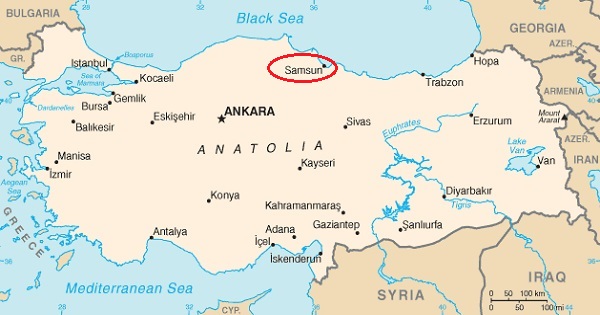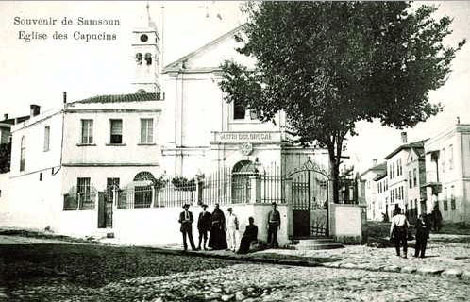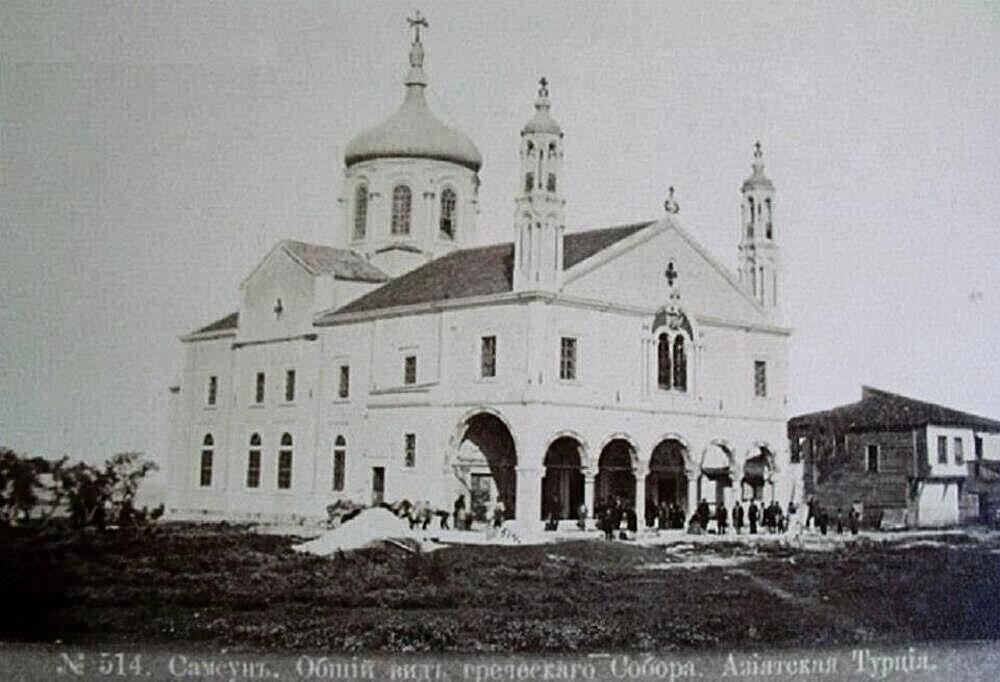
Amisos, otherwise known as Samsunta by Greeks, is today’s Samsun, a city situated on the shoreline of the historic region of Pontus, in today’s Turkey. The name Samsunta is derived from Amisos; Eis Amison (towards Amisos) -> s’Amison -> s’Amson -> Samsunta. There are also other variants of the name including; Simisso (Genoese), Aminsos (Byzantine) and Misso (Roman). The Turks today call it Samsun.
The city was colonised by the Ionians of Sinope or the Miletians in the 8th century BC. Due to its location it played an important role both politically and economically during the Hellenistic, Roman and Byzantine periods. The city was also one of Mithradates’ major cities.
During its time under Turkish rule and up until the middle of the 19th century it was nothing more than an insignificant town. Things changed dramatically for Amisos after the Crimean War (1856). Many contributed to its growth. The rise in use of steamships and sea navigation in the Euxine contributed to the growth of many cities including Amisos. Later it was the fertility of its land and the geographic location of the town which attracted Greek merchants and tradespeople who brought their trade with them. In this way the Greek community began to flourish and included Greeks from neighbouring Trebizond, Oinoi, Cappadocia, Constantinople as well as other Greeks from Greece itself.
The Greek Orthodox cathedral of Hagia Triada (Holy Trinity). To the left of the church was a boys' school and to the right a girls' school. Read more
The town reached its trade and economic peak when the population of the region started working exclusively in the cultivation of tobacco. The quality of tobacco in the Amisos region is the best in all of Turkey. Within 30-40 years the Greek population of Amisos not only increased in number but also grew in economic wealth. Amisos was to also attract many Europeans primarily due to its monopoly in tobacco trade.
By 1910, the Greeks, Armenians, or Franks controlled no fewer than 142 of the town’s 156 businesses and 85% of the share of the Bafran tobacco market.1 The once insignificant Anatolian town had now been transformed into a transit destination point for European goods for transport to the Anatolian interior, as well as the point from where local products was exported to Europe. This gives an indication as to how the town grew economically and politically towards the end of the 19th and the beginning of the 20th centuries.

The catholic church Mater Dolorosa of Samsun.
The population statistics of the town are not exact however, according to the Encyclopedia of Pontian Hellenism (Malliaris 1992) in the year 1900 the town had a population of 22,000 made up of 10,000 Turks, 9,000 Greeks, 2,000 Armenians and other minorities while in 1914 the town was made up of 40,000 residents which comprised 20,000 Greeks, 16,500 Turks, 2,000 Armenians and 1,500 other ethnicities.
According to the 1914 Ottoman census, the Sanjak of Canik (Samsun) which incorporated Samsun, Unye, Bafra, Fatsa, Carsamba and Terme comprised 98,739 Greek Orthodox residents out of a total of 393,302 in other words 24.9% of the population. Samsun itself comprised 54,709 Greek Orthodox residents out of a total of 105,044 in other words 52% of the population.
After 1914 the Greek and Armenian populations was to dwindle considerably due to organised death marches and other methods used by Ottoman or Kemalist authorities during the Greek and Armenian Genocides. The Christian populations suffered extreme hardships over a period spanning almost a decade (1914-1923). Of the 20,000 Greeks few managed to survive the genocide. Those who did were sent to Athens, Pireaus, Salonica and other destinations in Greece as part of the Exchange of Populations.
It’s worth noting the Greek community’s achievements in education and communal life up until then.
In 1914, the town comprised a kindergarten with 500 children, a 7-grade primary school (400 students) a high school (200 students) as well as a 7-grade girl’s school (400 students).
There were also the following community organisations;
The Charitable Brotherhood ‘Orthodoxia’
The Charitable brotherhood of Gentlemen
The Pan-Euxinus Greek Society ‘Αναγέννησις’ (an athletics organisation which organised the athletic games of 28-29 June 1909 between all the athletic clubs of Pontus).
There was also:
The Music Society ‘Orpheus’
The Greek Merchants Club
The Brotherhood ‘Πατριάρχης Φώτιος ο Ομολογητής’
The Political Society ‘Pericles’
The Society of Oinoians
The Society of Sinope
The Society of Tobacco Workers.
Amisos also published the Greek newspaper Φως (Light) first weekly and later bi-weekly (1912-1914). Today Amisos (called Samsun) is one of the most populated of all the sea side cities on the Black Sea coast of Turkey with a population of 500,000.
References:
1. Anthony Bryer. The Byzantine Monuments and Topography of the Pontos. Dumbarton Oaks, p 94.
Primary source:
The Encyclopaedia of Pontian Hellenism
See also:
The Greek settlements of Samsunta
Amisos: A history
